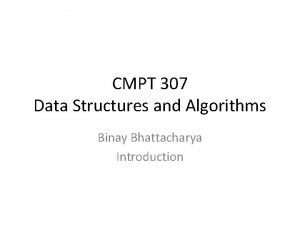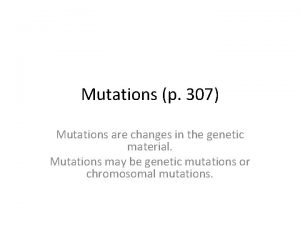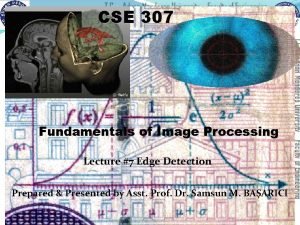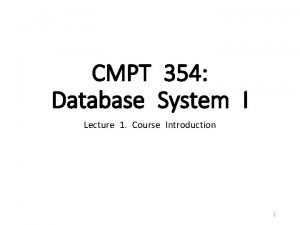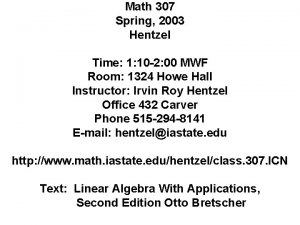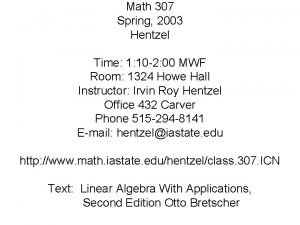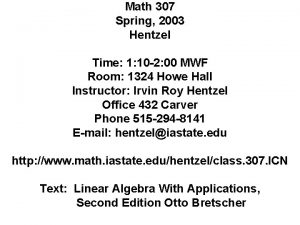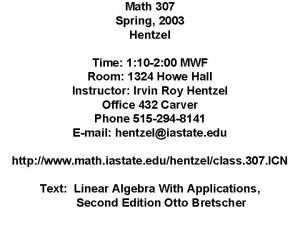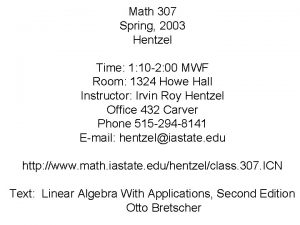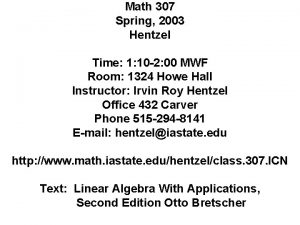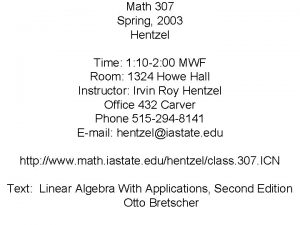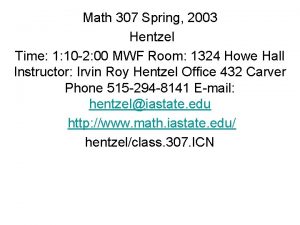Math 307 Spring 2003 Hentzel Time 1 10


![Theorem: If A n x n is any square matrix, then Det[A] = n+1 Theorem: If A n x n is any square matrix, then Det[A] = n+1](https://slidetodoc.com/presentation_image/fabd5120065905e848d0cf39e173d3dd/image-3.jpg)
![Proof Det [A] = SUM sgn(p) a 1 p(1) a 2 p(2). . . Proof Det [A] = SUM sgn(p) a 1 p(1) a 2 p(2). . .](https://slidetodoc.com/presentation_image/fabd5120065905e848d0cf39e173d3dd/image-4.jpg)

![Det[A] = SUM sgn(p) a 1 p(1) a 2 p(2) …a n p(n) p Det[A] = SUM sgn(p) a 1 p(1) a 2 p(2) …a n p(n) p](https://slidetodoc.com/presentation_image/fabd5120065905e848d0cf39e173d3dd/image-6.jpg)
![Det[A] = SUM sgn(p) a 11 a 2 p(2). . . a n p(n) Det[A] = SUM sgn(p) a 11 a 2 p(2). . . a n p(n)](https://slidetodoc.com/presentation_image/fabd5120065905e848d0cf39e173d3dd/image-7.jpg)
![Det[A] = a 11 SUM sgn(p) a 2 p(2). . . a n p(n) Det[A] = a 11 SUM sgn(p) a 2 p(2). . . a n p(n)](https://slidetodoc.com/presentation_image/fabd5120065905e848d0cf39e173d3dd/image-8.jpg)
![These SUMS are close to Det[Aij]. The only difference is that the sgn(p) is These SUMS are close to Det[Aij]. The only difference is that the sgn(p) is](https://slidetodoc.com/presentation_image/fabd5120065905e848d0cf39e173d3dd/image-9.jpg)
![Det[A] = a 11 Det[A 11] - a 12 Det[A 12] + a 13 Det[A] = a 11 Det[A 11] - a 12 Det[A 12] + a 13](https://slidetodoc.com/presentation_image/fabd5120065905e848d0cf39e173d3dd/image-10.jpg)
![n Theorem: Det[A] = Sum (-1) i+j aij Det[Aij] j=1 th Proof: This is n Theorem: Det[A] = Sum (-1) i+j aij Det[Aij] j=1 th Proof: This is](https://slidetodoc.com/presentation_image/fabd5120065905e848d0cf39e173d3dd/image-11.jpg)

![This can be written as Det[A] = SUM (-1) i+j-2 aij Det[Aij] Which can This can be written as Det[A] = SUM (-1) i+j-2 aij Det[Aij] Which can](https://slidetodoc.com/presentation_image/fabd5120065905e848d0cf39e173d3dd/image-13.jpg)
![Definition: Given a matrix A, then |+Det [A 11] |-Det [A 12] Adj(A) =|+Det Definition: Given a matrix A, then |+Det [A 11] |-Det [A 12] Adj(A) =|+Det](https://slidetodoc.com/presentation_image/fabd5120065905e848d0cf39e173d3dd/image-14.jpg)
![Theorem: A Adj(A) = Adj(A) A = Det[A] I Theorem: A Adj(A) = Adj(A) A = Det[A] I](https://slidetodoc.com/presentation_image/fabd5120065905e848d0cf39e173d3dd/image-15.jpg)



![Theorem: Det[A] = Det[AT] Proof: Since (A-1)T = (AT) -1 If A is invertible, Theorem: Det[A] = Det[AT] Proof: Since (A-1)T = (AT) -1 If A is invertible,](https://slidetodoc.com/presentation_image/fabd5120065905e848d0cf39e173d3dd/image-19.jpg)

![Find the Determinant of differentiation on the space with basis Sinh[x] Cosh[x]. Sinh[x] 0 Find the Determinant of differentiation on the space with basis Sinh[x] Cosh[x]. Sinh[x] 0](https://slidetodoc.com/presentation_image/fabd5120065905e848d0cf39e173d3dd/image-21.jpg)








- Slides: 29

Math 307 Spring, 2003 Hentzel Time: 1: 10 -2: 00 MWF Room: 1324 Howe Hall Instructor: Irvin Roy Hentzel Office 432 Carver Phone 515 -294 -8141 E-mail: hentzel@iastate. edu http: //www. math. iastate. edu/hentzel/class. 307. ICN Text: Linear Algebra With Applications, Second Edition Otto Bretscher

Friday, April 4 Chapter 6. 2 Page 266 Problem 4, 14, 46, 48 Main Idea: Expand along any row or column. Key Words: Adjoint, Aij Det[A] = SUM sgn(p) a 1 p(1) a 2 p(2). . . a n p(n) all p Goal: Learn how to expand a determinant.
![Theorem If A n x n is any square matrix then DetA n1 Theorem: If A n x n is any square matrix, then Det[A] = n+1](https://slidetodoc.com/presentation_image/fabd5120065905e848d0cf39e173d3dd/image-3.jpg)
Theorem: If A n x n is any square matrix, then Det[A] = n+1 a 11 Det[A 11] - a 12 Det[A 12]+. . . +(-1) Det[A 1 n] Where Aij is the n-1 x n-1 matrix obtained by deleting row i and column j from A.
![Proof Det A SUM sgnp a 1 p1 a 2 p2 Proof Det [A] = SUM sgn(p) a 1 p(1) a 2 p(2). . .](https://slidetodoc.com/presentation_image/fabd5120065905e848d0cf39e173d3dd/image-4.jpg)
Proof Det [A] = SUM sgn(p) a 1 p(1) a 2 p(2). . . a n p(n) all p There are n possible choices for a 1 p(1). One can choose any element from the top row. The possibilities are a 11, a 12, . . . a 1 n.

We split up the sum into n parts depending on which element was chosen from the top row.
![DetA SUM sgnp a 1 p1 a 2 p2 a n pn p Det[A] = SUM sgn(p) a 1 p(1) a 2 p(2) …a n p(n) p](https://slidetodoc.com/presentation_image/fabd5120065905e848d0cf39e173d3dd/image-6.jpg)
Det[A] = SUM sgn(p) a 1 p(1) a 2 p(2) …a n p(n) p (1)=1 + SUM sgn(p) a 1 p(1) a 2 p(2) . . a n p(n) p(1)=2 + SUM sgn(p) a 1 p(1) a 2 p(2) p(1)=3 … a n p(n) : + SUM sgn(p) a 1 p(1) a 2 p(2) … a n p(n) p(1)=n
![DetA SUM sgnp a 11 a 2 p2 a n pn Det[A] = SUM sgn(p) a 11 a 2 p(2). . . a n p(n)](https://slidetodoc.com/presentation_image/fabd5120065905e848d0cf39e173d3dd/image-7.jpg)
Det[A] = SUM sgn(p) a 11 a 2 p(2). . . a n p(n) p(1) = 1 + SUM sgn(p) a 12 a 2 p(2). . . a n p(n) p(1) = 2 + SUM sgn(p) a 13 a 2 p(2). . . a n p(n) p(1) = 3 : + SUM p(1) = n sgn(p) a 1 n a 2 p(2). . . a n p(n)
![DetA a 11 SUM sgnp a 2 p2 a n pn Det[A] = a 11 SUM sgn(p) a 2 p(2). . . a n p(n)](https://slidetodoc.com/presentation_image/fabd5120065905e848d0cf39e173d3dd/image-8.jpg)
Det[A] = a 11 SUM sgn(p) a 2 p(2). . . a n p(n) p(1) = 1 + a 12 SUM sgn(p) a 2 p(2). . . a n p(n) p(1) = 2 + a 13 SUM p(1) = 3 + a 1 n SUM p(1) = n sgn(p) a 2 p(2). . . a n p(n) : sgn(p) a 2 p(2). . . a n p(n)
![These SUMS are close to DetAij The only difference is that the sgnp is These SUMS are close to Det[Aij]. The only difference is that the sgn(p) is](https://slidetodoc.com/presentation_image/fabd5120065905e848d0cf39e173d3dd/image-9.jpg)
These SUMS are close to Det[Aij]. The only difference is that the sgn(p) is based on all n positions of p(1) p(2) p(3). . . p(n). In Det [A ij] the sgn is based on n-1 positions of p(2) p(3). . . p(n).
![DetA a 11 DetA 11 a 12 DetA 12 a 13 Det[A] = a 11 Det[A 11] - a 12 Det[A 12] + a 13](https://slidetodoc.com/presentation_image/fabd5120065905e848d0cf39e173d3dd/image-10.jpg)
Det[A] = a 11 Det[A 11] - a 12 Det[A 12] + a 13 Det[A 13]. . (-1)n+1 a 1 n Det[A 1 n]
![n Theorem DetA Sum 1 ij aij DetAij j1 th Proof This is n Theorem: Det[A] = Sum (-1) i+j aij Det[Aij] j=1 th Proof: This is](https://slidetodoc.com/presentation_image/fabd5120065905e848d0cf39e173d3dd/image-11.jpg)
n Theorem: Det[A] = Sum (-1) i+j aij Det[Aij] j=1 th Proof: This is expansion by the i row.

We first interchange rows i-1 times to move th the i row to the first row. Then we expand along the first row. This gives | ai 1 Det[Ai 1] | | Det[A]=(-1)i-1 | - a i 2 Det[Ai 2] | + ai 3 Det[Ai 3] | | : | n+1 | (-1) ain Det[Ain] |
![This can be written as DetA SUM 1 ij2 aij DetAij Which can This can be written as Det[A] = SUM (-1) i+j-2 aij Det[Aij] Which can](https://slidetodoc.com/presentation_image/fabd5120065905e848d0cf39e173d3dd/image-13.jpg)
This can be written as Det[A] = SUM (-1) i+j-2 aij Det[Aij] Which can be simplified since (-1)2 = 1 to Det[A] = SUM (-1)i+j aij Det[Aij]
![Definition Given a matrix A then Det A 11 Det A 12 AdjA Det Definition: Given a matrix A, then |+Det [A 11] |-Det [A 12] Adj(A) =|+Det](https://slidetodoc.com/presentation_image/fabd5120065905e848d0cf39e173d3dd/image-14.jpg)
Definition: Given a matrix A, then |+Det [A 11] |-Det [A 12] Adj(A) =|+Det [A 13] |-Det [A 14] |. |. |. - Det [A 21] + Det [A 22] - Det [A 23] + Det [A 24]. . . +Det [A 31]. . | -Det [A 32]. . | +Det [A 33]. . | -Det [A 34]. . |. |
![Theorem A AdjA AdjA A DetA I Theorem: A Adj(A) = Adj(A) A = Det[A] I](https://slidetodoc.com/presentation_image/fabd5120065905e848d0cf39e173d3dd/image-15.jpg)
Theorem: A Adj(A) = Adj(A) A = Det[A] I

Find the inverse of | 317| | 123| | 231|

check T |3 1 7| | -7 (-5) -1| |-7 20 -11| | -23 0 0| Adj|1 2 3| =|(-20)-11 (7)| = |5 -11 -2 | | 0 -23 0| |2 3 1| | -11 (2) 5 | | -1 -7 5| | 0 0 -23 |

| 3 1 7 | -1 | -7 20 -11 | | 1 2 3 | = -1/23 | 5 -11 -2 | | 231| | -1 -7 5 |
![Theorem DetA DetAT Proof Since A1T AT 1 If A is invertible Theorem: Det[A] = Det[AT] Proof: Since (A-1)T = (AT) -1 If A is invertible,](https://slidetodoc.com/presentation_image/fabd5120065905e848d0cf39e173d3dd/image-19.jpg)
Theorem: Det[A] = Det[AT] Proof: Since (A-1)T = (AT) -1 If A is invertible, then A is a product of Elementary Row Operation Matrices. For Elementary Row Operation Matrices Det [ET] = Det [E], we have Det [A] = Det[AT]. If A is not invertible, then neither is AT T and Det [A] = Det[A ] = 0.

Theorem: The determinant of a linear transformation is invariant under change of basis. Proof: Det [ P -1 A P] = Det[P-1] Det [A] Det [P] = Det[ P-1 P] Det [A] = Det [A].
![Find the Determinant of differentiation on the space with basis Sinhx Coshx Sinhx 0 Find the Determinant of differentiation on the space with basis Sinh[x] Cosh[x]. Sinh[x] 0](https://slidetodoc.com/presentation_image/fabd5120065905e848d0cf39e173d3dd/image-21.jpg)
Find the Determinant of differentiation on the space with basis Sinh[x] Cosh[x]. Sinh[x] 0 Cosh[x] 1 0 Det[ derivation ] = -1.

Find the Determinant of differentiation on the x -x space with basis e , e. ex e -x ex 1 0 e -x 0 -1 Det [ derivation ] = -1.

Page 263 Example 8. A= |1012| |9130| |9220| |5003| Find the determinant of A.

Add -2 Row 2 to row 3 |1012| |9130| |-9 0 -4 0 | |5003|

Expand along second column |1 +1 | |-9 |5 1 2| | -4 0 | 0 3|

Add 4 Row 1 to Row 2 |1 +1 | |-5 |5 12| | 08| 03|

Expand along column 2 | (-1) | |-5 |5 | | 8| 3| Evaluate the final 2 x 2 determinant. -(-15 - 40) = 55.

Page 265 Problem 5. |11111| |12222| A=|11333| |11144| |11115| Find the determinant of A.

Eliminate the first column |11111| |01111| A=|00222| |00033| |00004| The determinant of a triangular matrix is the product of the elements on the diagonal. Det [A] = 24.
 Spring, summer, fall, winter... and spring cast
Spring, summer, fall, winter... and spring cast Autumn season months
Autumn season months Iso/tc 307
Iso/tc 307 Cmpt 409
Cmpt 409 Byk 333
Byk 333 Xm 307
Xm 307 Kaman dayron
Kaman dayron P 307 2016
P 307 2016 30 tac 307
30 tac 307 Jack warecki
Jack warecki Wac 296-305
Wac 296-305 360-307
360-307 Iso/tc 307 blockchain and distributed ledger technologies
Iso/tc 307 blockchain and distributed ledger technologies Wac 296-307
Wac 296-307 Ce307
Ce307 Szkoła podstawowa nr 307
Szkoła podstawowa nr 307 Mis 307
Mis 307 Cse 307
Cse 307 Cmpt307
Cmpt307 Buad 307
Buad 307 Sfu cmpt 307
Sfu cmpt 307 Math enrichment spring 2020
Math enrichment spring 2020 Example of elapsed time
Example of elapsed time Spring is coming
Spring is coming Hit the button
Hit the button Microsoft word 2003 tutorial
Microsoft word 2003 tutorial Wpc2003
Wpc2003 Sbs 2003 cals
Sbs 2003 cals Windows server 2003 sp
Windows server 2003 sp Kc baking powder can where the red fern grows
Kc baking powder can where the red fern grows



